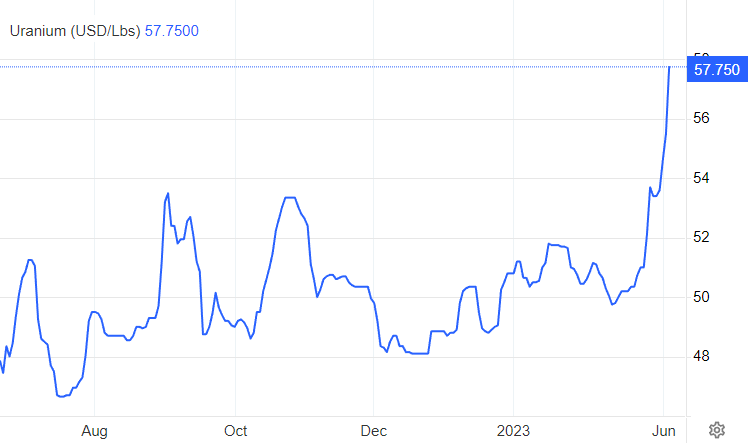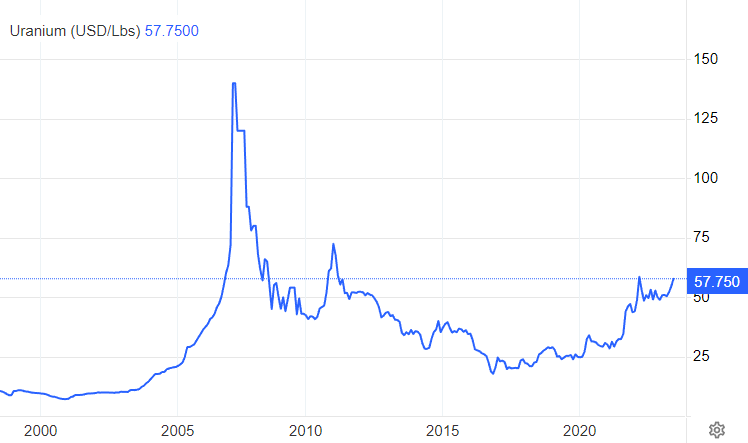The commodity opportunity you may have overlooked... but should not ignore
Energy transition, electrifying the world, the green push… They’re all good stories – both in terms of the narratives themselves and the potential impacts of the commodities in question.
But let’s be clear. There is one thing that drives commodity prices and one thing only.
Supply and demand.
If there is more demand for a commodity than there is supply, prices will go up and so too will the companies that extract that commodity from the ground.
That is really the only prism through which investors should view the ‘prospects’ for a commodity. Of course, people can add their politics and ESG preferences as they see fit, but those factors will not drive commodity or share prices over the long term.
Instead, the structural undersupply of a commodity that is needed to power or build the world is what will drive sustainably higher prices and investment opportunities.
With that in mind, I recently spoke to Guy Keller, head of the Tribeca Nuclear Energy Opportunities Fund, for his perspective on the uranium market, why it is often overlooked by Australian investors, as well as some of the key opportunities in the space.
The size of the opportunity
As Keller eloquently puts it, “The opportunity starts with a very big disconnect in the fundamentals of supply and demand."
He goes on to point out that the uranium industry has had a decade of undersupply, largely due to the events of the Fukushima tsunami, and that the deficit during the period has been filled by inventory – as opposed to new supply.
Fast forward to today, when energy security has become a major global issue, governments are extending the life of reactors as a result, and the world is in the midst of the biggest reactor build program in decades, and supply and demand are completely off kilter.
There are 17 countries building 55 reactors that will come online between now and 2026. To put that in perspective, there are 410 operable reactors in the world as of May 2023.
“We are in a market currently producing around 125 million pounds of uranium but consuming 180 millions pounds from the existing reactors alone - so we're already in deficit.
These 55 new reactors will require an additional 25 million pounds of uranium a year." Keller says.
With the 55 new reactors coming online, total annual consumption will be north of 200 million pounds, a long way from the 125 million being produced currently.
“That demand equation continues to run away in at least the next decade or two," Keller says.
Other tailwinds
As well as a lack of mine development and more powerplants coming online, Keller notes a couple of other factors that are tailwinds.
This includes the Inflation Reduction Act (IRA), which has seen the US government really focus on its own energy security but also the impact nuclear energy can have on energy security globally.
“They're pumping a huge amount of money into future technologies, and rolling out existing reactor technology to the world, especially with geopolitical disruption, because Russia was a big competitor in building reactors in emerging countries," Keller explains.
The other tailwind has been the Russia/Ukraine crisis, which has caused the US and other Western governments to look at securing the fuel cycle.
“So there's a sort of dual tailwind there, where the US is focusing on itself via the IRA, whilst the Russia conflict has caused a massive rethink about energy security globally," Keller says.
Overlooked opportunity
Australia is a country blessed with a plethora of commodity opportunities. Iron ore, oil, gold, rare earths, lithium, and graphite, to name just a few. Australia is also not a nuclear electricity-producing country, despite having nuclear technology in use at Lucas Heights in Sydney, producing nuclear medicine.
It is perhaps for these reasons, and the negative stigma of past events, that sees uranium often overlooked by Australian investors.
“When I compare the Australian investor to North Americans and Europeans, they're much more comfortable with the thesis because they can see it being generated in electricity," notes Keller.
“Australian investors tend to look at it from a mining commodity perspective, and there's not a lot of uranium mining that happens in Australia. So that competes with your lithiums and your rare earths that just get a lot more broker attention, analyst attention and media attention."
How high can prices go?
When I spoke to Keller, the price of uranium was sitting around US$56 per pound. Upon asking Keller about his outlook for prices, he said the following:
“I used to subscribe to the idea that US$60 was a medium-term incentive price to bring supply to the market. I'm now of the view that that price is a minimum of US$75," he said.

Keller’s view is based on the forward demand for uranium, noting that more demand is coming online but there's little extra supply.
“Remember, tomorrow for a nuclear utility is three years’ time because it takes two to three years to get uranium from the mine mouth to the reactor core because it goes through the fuel cycle," he says.
Keller believes that the price needs to be at a sustainable minimum of US$75 and that forms a baseline, but if previous cycles are anything to go by, prices will blow out.
“Last cycle, prices started at US$8 and ended up at US$140. So it will blow out and then it comes down to where long-term contracting settles," he explains.

How are you positioned?
The Tribeca Nuclear Energy Opportunities Fund has the mandate to invest in companies all up and down the value chain – from explorers to producers, to companies that provide the infrastructure to nuclear power plants.
But the portfolio currently has a key focus, notes Keller.
“We've got a big concentration towards the producing or funded-to-production type companies," he says.
Keller adds that these larger-cap liquid companies are where most investors want to be now, across most commodities – not just uranium - at this stage of the cycle.
Whilst most of the portfolio is made up of these types of companies, there is also some room for explorers.
“In the last cycle, we had 500 listed opportunities that had something to do with uranium. When I started looking at this six years ago, there were about 20, and there's maybe 50-odd that are serious right now," Keller says.
“There's a lot of potential diamonds that are starting to come to market that had good prospectivity and good momentum last cycle, but the rug got pulled when the capital markets walked away from the sector."
Australian focus
Keller notes that “Australia pops up as the second or third largest country in the world by uranium resource. The majority of that, however, sits in BHP's (ASX: BHP) Olympic Dam Deposit."
Outside of that, there aren’t a great deal of ASX-listed, Australian uranium producers, although Boss Energy (ASX: BOE) is a name he likes.
“Boss Energy is funded to production. It's a restart project based in South Australia, which is a really phenomenal uranium mining jurisdiction, very supportive, obviously with BHP and Heathgate there," Keller says.
And they'll be producing their first drum of yellowcake, which is the uranium raw material, in the fourth quarter of this year”.
Keller adds that the ASX does have a good cross-section of uranium exposure, despite not a lot of the companies having projects in Australia.
He identifies Nexgen Energy (ASX: NXG) with operations in Canada. Despite not being particularly liquid, it “gives you leverage to the Arrow project, at the west of the Athabasca Basin - a high grade, 25 million pounds a year resource which it will be producing the latter part of this decade."
“That's the standout and it's the largest uranium-focused market cap on the ASX," he says.
Moving around the world, Keller also highlights Paladin (ASX: PDN) and its Langer Heinrich asset in Namibia.
“They're also funded to production and should be producing pounds in the first quarter of next year," he says.
For projects in the US, Keller identifies Peninsula Energy (ASX: PEN) as the play with the Lance project, “Again funded to production. They should be producing uranium in the next eight weeks."
So, why uranium?
As noted at the outset of this yarn, commodity prices are driven by supply and demand and, in the case of uranium, there is a structural, long-term imbalance that could drive prices higher for many years to come.
But, the question remains, why should investors choose uranium over the myriad of other commodity opportunities available to them?
“It's very simple," Keller says.
“The fundamentals. At these prices, at US$56-$57, there's not enough incentive to get enough uranium to production. Getting any mine into production, regardless of the commodity, is extraordinarily difficult in the current environment.
"You're not going to get a wall of supply even if the prices respond because there's a whole bunch of other things that need to happen," he says.
Keller points to previous cycles as a guide, noting that in the 70s the uranium price rallied 560% in large part due to the oil embargoes affecting the world at the time. In the 2000s, the uranium price rallied 1800% as China moved into the sector.
“We're really at the beginning of this cycle. We've rallied 200-odd percent and that's just its spot price," Keller says.
Whilst Keller firmly believes in the story, he notes it is not for everyone.
“It's volatile, and yes, it's a small opportunity set. If you don't like volatility, go and invest in iron ore and play the cycle. But if you're happy to wear that and looking for serious outsized returns, uranium could provide an opportunity," he says.
The final thought
For those still not convinced, Keller shares one final and compelling thought:
“If you're a lithium investor because you see the world pivoting in a massive way to battery electric vehicles, you've got to ask yourself, what are you plugging that into?" He asks.
"The answer needs to be nuclear power, which requires uranium."
4 topics
5 stocks mentioned
1 contributor mentioned

